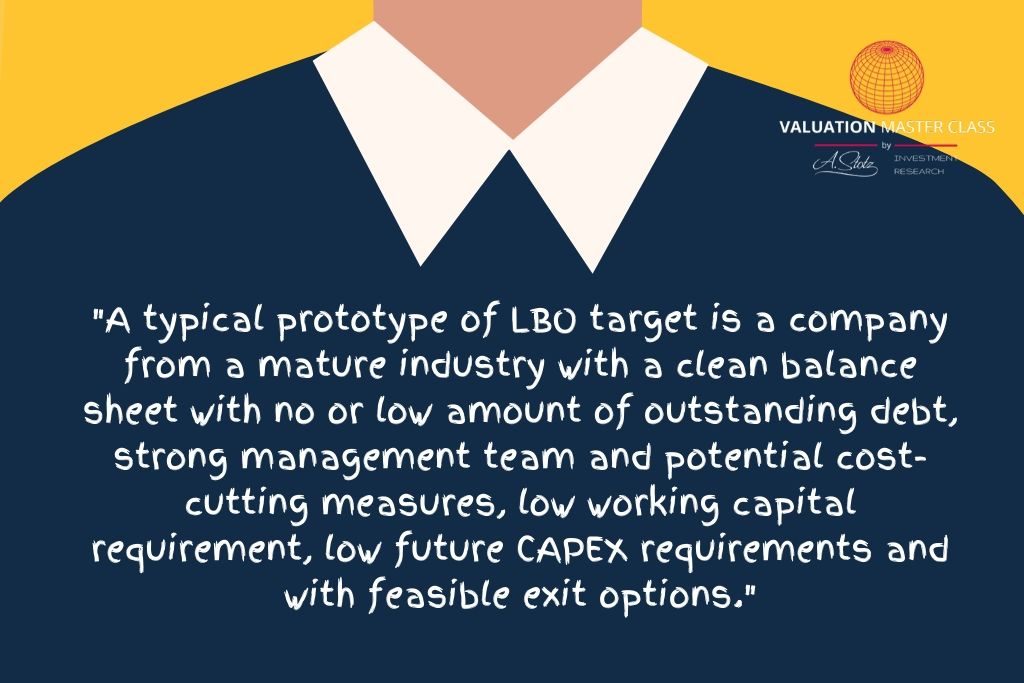Leveraged Buyouts
This is a Valuation Master Class student essay by Jana Kristofova from October 4, 2018. Jana wrote this essay in Module 4 and has since completed all five modules of the Valuation Master Class.
Leveraged Buyout (“LBO”) is a quite common term in Corporate Finance field. It refers to acquiring a company (or its part) and financing it with debt. The purpose of this paper is to give an overview of LBO transaction and its main features and in the end, a successful LBO story is mentioned and lessons learned are listed.
LBO Concept
Leveraged buyout (“LBO”) is an acquisition of an entire company or its division. The buyer (the “sponsor”) raises debt and equity to acquire the target. It borrows the majority of the purchase price and contributes proportionately small equity investment. The buyer continues to grow the company and improves its performance. The company’s free cash flow and proceeds from asset sales are used to repay outstanding debt. The buyer can potentially make add-on acquisitions and later sells or IPOs all or a portion of the company to exit the investment (NYU Stern, 2004).
The LBO ratios can go to 90% of debt and 10% of equity. A private equity firm aims a target return of around 20 – 25% (WallStreetMojo, 2018).
One of the largest LBOs was the acquisition of TXU Inc in 2007 by Kohlberg Kravis Roberts, Texas Pacific Group and Goldman Sachs. The acquisition transaction value was around US$ 43.8 bn.
The concept of an LBO transaction is simple – private equity buys a company, fixes it up, repays its debt and then sells the company for a higher price to earn the profit.
A typical prototype of LBO target is a company from a mature industry with a clean balance sheet with no or low amount of outstanding debt, strong management team and potential cost-cutting measures, low working capital requirement, low future CAPEX requirements and with feasible exit options.
LBO Types
LBOs are usually used for the following three purposes:
- Taking a public company private – it can occur in two forms: a) friendly – when e. g. management of a company decides to take the company private and uses debt for paying for acquisition; b) hostile – when other investors decide to take over the company, take it private and use debt for paying for the acquisition.
- Financing spin-offs – when a company decides to sell a part of the company and the deal is financed by debt;
- Private deals – when e. g. owner of the family business sells his business to e. g. an employee and the employee uses debt for financing a transaction.
LBO Analysis and its Steps
A LBO analysis is composed of the following steps (Chambers et al., 2015):
- Assumption of a purchase price, debt interest rate, etc.;
- Creating sources and uses (amounts required to effectuate the transaction) of funds;
- Financial projections of financial statements – income statement, balance sheet, cash flow statement for 5 years;
- Balance sheet adjustments for the new debt and equity;
- Exit strategies;
- the general assumption is that the company will be sold after 5 years at the same implied EBITDA multiple at which the company was purchased (but not necessarily).
- Calculation of internal rate of return (“IRR”) on the initial investments;
- calculation of the sale value of the company serves as a basis for the calculation of IRR of the investment for the private equity firm.
LBO’s Typical Credit Statistics
As per Macabacus (2018), the typical credit statistics can be (those can change with market conditions):
Total Debt / EBITDA 4.5x -5.5
Senior Bank Debt / EBITDA 3.0x
EBITDA / Interest Coverage > 2.0x
(EBITDA – CAPEX) / Interest Coverage >1.6x
Sources of Funds and Sources of Revenue in LBO
Sources of debt to finance a LBO transaction (WallStreetMojo, 2018):
- Revolving credit facility
- Senior term bank debt
- Mezzanine debt
- Subordinated or high-yield notes
- Seller notes
- Common Equity
LBO’s sources of revenue (WallStreetMojo, 2018):
- Carried interest – profit from the acquisition that is split between a general partner and limited partners. A general partner in a private equity firm usually earns 20% of the profit.
- Management fees – between 0.7 and 3% of the committed capital. The usual market practice is 2% of the committed capital.
- Co-investment – employees and executives of the LBO firm can participate in investing/ co-investing in LBO transactions.
Exit Strategies
Exit strategies are used by the private equity firm after selling the company after e. g. 5 years. An exit strategy helps the financial buyer to realize gains on their investments. An exit strategy can be a sale of the company to a strategic buyer, recapitalization (a sale of the company to another financial sponsor) or to take a company public via IPO.
LBO Stories
There are many successful and unsuccessful LBO stories. Hilton Hotels case is believed to be one of the best LBO transactions of all time. In the peak of the real estate bubble in 2017, Blackstone Group decided to buy Hilton for US$26 bn in a LBO transaction. Shortly after markets experienced a deep crisis. It was the worst timing. However, in 2013 Hilton decided to go public and the deal appeared to be the most profitable private equity deal ever (Walton, 2018).
Furthermore, Walton (2018) states that one of the most important factors related to LBOs is timing. The best time for LBOs is during times when interest rates are low (therefore the cost of borrowing is low) and when a company (target) is undervalued or performing poorly.
References
Chambers, D. R. et al. (2015). Alternative Investments: CAIA Level I. 3rd Edition, CAIA Association.
Macabus (2018). Capital Structure of an LBO.
Stern NYU (2004). The Art of the LBO.
WallStreetMojo (2018). Leverage Buyout, LBO Analysis.
Walton, J. (2018). 10 most famous leveraged buyouts.
